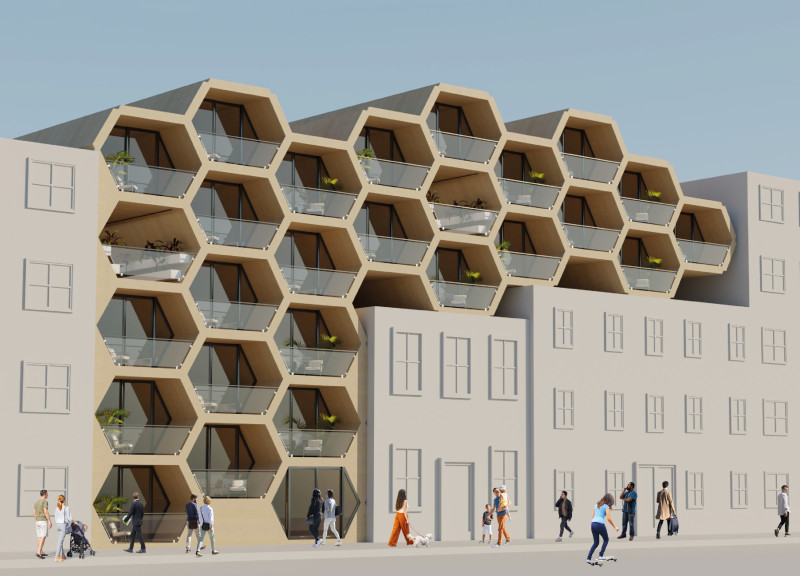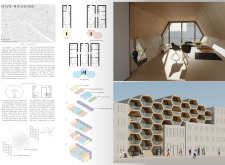5 key facts about this project
The concept behind Hive Housing leverages modularity as its core principle, allowing individual units to be reconfigured or expanded as necessary. This design approach prioritizes space efficiency, enabling residents to optimize their living conditions according to their evolving lifestyle needs. The project's hexagonal design reflects natural forms, reminiscent of honeycombs, which symbolize collaboration and community. Each residential unit is thoughtfully designed to maximize functionality while providing comfortable living spaces that enhance the quality of life for its inhabitants.
The architectural composition of Hive Housing is characterized by its use of modern materials that promote both aesthetic appeal and structural integrity. Wood is extensively utilized in interior finishes and structural components, providing warmth and creating a welcoming atmosphere. In conjunction with wood, large glass panels serve as a significant design element, allowing abundant natural light to flood the interiors and connecting residents visually with the surrounding environment. The incorporation of steel is evident in the framework of the building, ensuring longevity and safety within the modular design. Concrete is employed in foundational elements, offering the necessary stability essential for such an innovative architectural endeavor.
Key design details are evident throughout the Hive Housing project. The hexagonal units align to create cohesive clusters, enhancing both the architectural rhythm and the sense of community among residents. Shared communal areas, such as gardens and outdoor terraces, further promote social interaction, allowing individuals to engage in meaningful ways while maintaining privacy within their personal units. The careful placement of windows fosters cross ventilation, contributing to a sustainable indoor climate by minimizing reliance on artificial heating and cooling.
Unique design approaches implemented in Hive Housing set it apart from traditional residential structures. The focus on flexibility allows residents to customize their living environments easily, which is particularly beneficial in urban settings where housing demands can fluctuate. The project's commitment to sustainability is evident not only in its material choices but also in its spatial ordering, which encourages a lifestyle that embraces both communal living and personal autonomy.
The architectural design of Hive Housing invites exploration into various facets of its making. For those interested in understanding the intricacies of this project, examining the architectural plans, sections, and detailed designs offers valuable insights into the thoughtful considerations that shaped this innovative housing model. Each element of the design process contributes to a greater understanding of how Hive Housing responds to contemporary urban challenges.
In an era where urbanization presents complex issues related to housing, community, and sustainability, Hive Housing emerges as a relevant and insightful contribution to the discourse surrounding modern architecture. The project stands as a testament to how flexible design, when combined with sustainable practices, can create living spaces that not only meet practical needs but also promote a deeper sense of community. To gain further insights, readers are encouraged to delve into the project presentation and explore its rich details.























